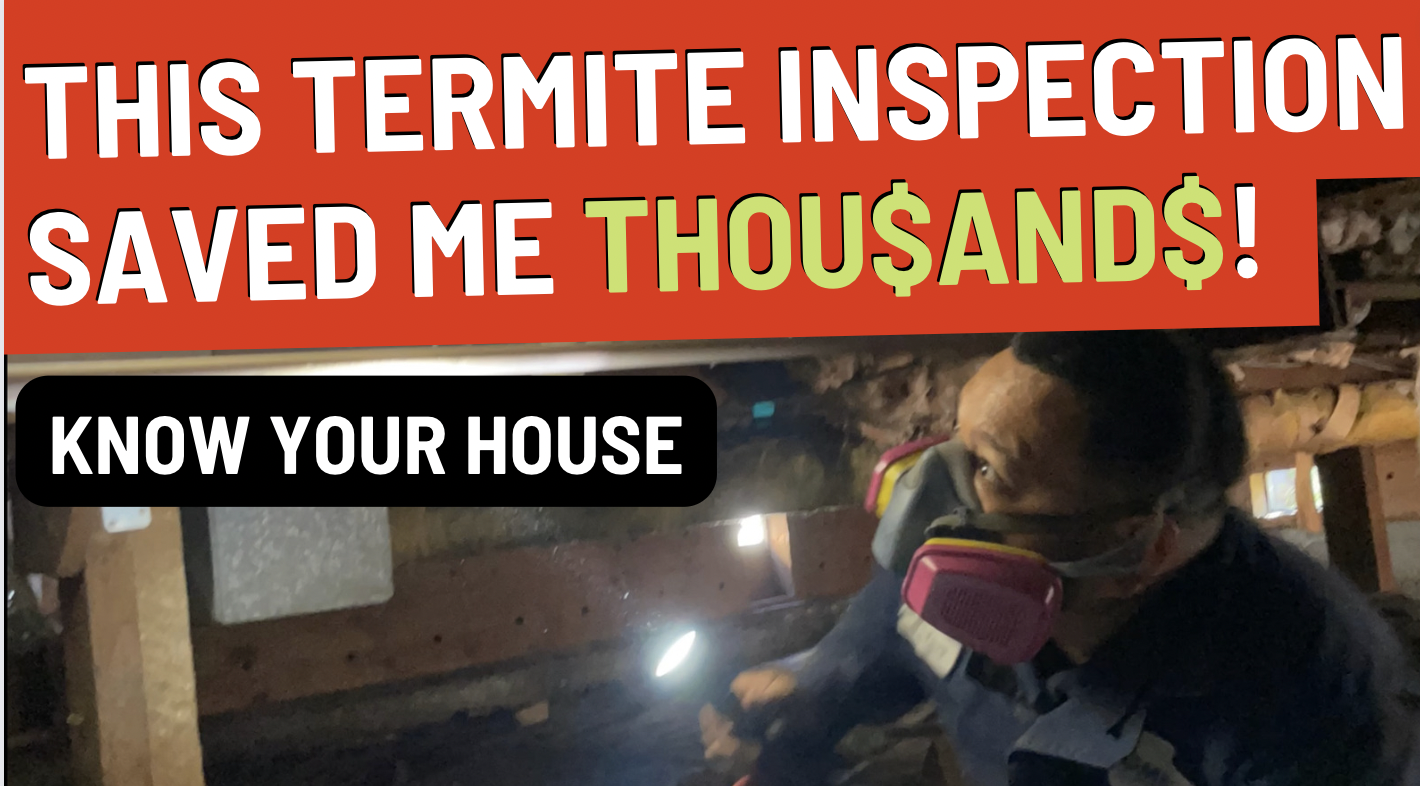True confessions: I never had extermination done after buying my house years ago. After all, no termites were crawling or flying around. How did we know if the termites were old school or a current infestation?
Then there was a live termite incident. Three different pest inspection companies did estimates, with three wildly different recommendations.
The 3rd was Omega Termite and Pest Control, whom many East Bay real estate agents use for pest reports as part of a home sale. (East Bay Structural and GT Inspects are some other highly regarded Berkeley and Oakland pest inspection companies, among others.)
Things I learned by talking to my pest inspector:
Omega’s inspector Gustavo let me follow him around…and we made some major discoveries that the issues were more minor than I expected.
Please watch & share, especially if you have a dirt crawl space!
These are things I gleaned from our time together — ask a pest inspector if it’s all accurate which will help you learn too (and tell me if I’m off base!)
- #1 TIP!!! Cover your dirt crawl space floor: The first investment a home owner should make is if you have a dirt floor crawl space, look at covering it with a 6 mm “visqueen” or plastic barrier you can get at stores like Home Depot. This will not only make it easier for people to work in the crawl space but it will tamp those subterranean termites back where they belong — in the ground.
- Keep the soil clean and free of debris. Any wood pieces, paper or cardboard on soil is food for your pet termites. Get rid of it. (If the debris is ON the plastic barrier, it is less of an issue according to the inspector.)
- Wood-destroying beetles seek out softer woods, not redwood. If you have redwood framing under your house, your house is probably very solid. Think twice before removing the redwood during a remodel!
- Beetles make little holes that look like you used a small ice pick to hit at wood.
- You will never see the beetles that chew up your house. I’m told they make the holes but don’t live in the wood. (Where do they live?) Anyway, apparently treating the wood with chemicals is the way to stop them.
- Tenting a house is the best way to get rid of a beetle infestation. If you are thinking of selling your house in the coming years, you can probably wait till you have moved out everything to tent. It is a really big deal to tent your house.
- Spraying orange oil where you live upstirs may be great for killing ants. However orange oil is pretty much useless for treating subterranean termites. Those termites go back down into the ground.
- Stopping water intrusion is the first thing you need to do. Both with this inspection and house inspections for my clients, water intrusion always comes up. Whether through the attic, through windows, roof leaks, from leaking pipes, or under the house, water is the enemy of your home.
Learn everything about your house with the book Renovation.
A general contractor from Berkeley, California co-authored the book. It has gone through several printings because it is such a classic manual to everything you need to know about your house.
Buy it from Berkeley’s independent seller Builder’s Booksource or your favorite book store.
It’s my favorite gift for new home buyers and as a thank you gift for client referrals!
Watch a real Termite Inspection Video in Rockridge
Prefer to read? Here’s the transcript from the video:
Omega Pest: There’s plenty dry rot in all of this. Looks like all the boards beneath the shingles rotted out in this area. Little bit of damage to the rim joist.
Home owner: So that’s where it was leaking under the porch. Like the concrete broke so I think over the years it’s just been rotting and rotting.
Omega Pest: It doesn’t look like anything recent or anything like that. Just an accumulation of damage throughout the years.
Alright, so we’re going to document this whole little corner, and we’re going to say “some existing damage.” What I do is to try to evaluate all of this and come up with a price to give you an idea of what it will cost.
A few beetle holes, if you look at those. They appear to be older.
The way we’re able to kind of come up with that is you look at the hole itself.
The hole appears to be a little bit dirty.
Usually if it’s a fresh beetle hole you can see the fresh bore.
So we’re going to keep in mind that beetles at some point were here.
Throughout the crawl space we’ll keep our eye out for that as well.
FOUNDATION INSPECTION
Omega Pest: This looks like it might be the original foundation down here. And then they’ve capped it over. So you’ve got another foundation that was poured over the original foundation. And they probably did that because more than likely it’s probably not cracked in multiple areas.
And usually if the foundation is not cracked, they’ll kind of just go over it.
SHEAR WALL RETROFITTING
Omega Pest: So looks like you’ve got some retrofitting, earthquake shear walls here.
You never know what might be going on behind it.
It’s always a good idea for an inspector to come out and see if you see anything. I can see that barrier behind the shingles out there, looks pretty decent.
CHECKING THE CRAWL SPACE DIRT FLOOR UNDER THE VISQUEEN 6 MM PLASTIC VAPOR BARRIER
Home owner: So, what do you see?
Omega Pest: A little damp. A little bit of moist soil beneath this plastic which is a good idea, a good thing that this plastic’s here because it’s helping keep all this down and off of this framing here.
So dampness in the crawl space shouldn’t be happening but there isn’t much we can do about it especially around these parts.
Home owner: Ya there’s actually a river a couple blocks away [Temescal Creek] and I think there’s a high water table here.
Omega Pest: A super high water table in this area for sure. So I mean that’s something a lot of people have — moisture underneath their house but plastic always keeps the humidity down and the moisture level down.
This is all redwood. Redwood joists. Redwood framing. Typically it takes a lot of work for a termite to do any damage to redwood. They’ll go for the softer wood.
You can see this is all solid, solid timber.
Always a good idea to keep those off the soil — any type of wood, or cardboard or paper, always a good idea to get that off or remove it.
You can see that someone has marked this throughout the years. S meaning subterranean.
Looks like maybe a little bit of damaged sheathing here.
Home owner: Do I need to get rid of these [piles of sawdust]? I know it normally says if you can rake it.
Omega Pest: So, the fact that this [sawdust] is over the plastic is no big deal. In another situation, if it was kind of piled up like this, and sitting on the dirt, with the moisture that’s down here, throughout the years, I’m sure it would develop a little bit of fungus.
So always a good idea if you can to blow it off. If it’s accumulated in a pile, that might be a problem.
There’s one maybe two little beetle holes there. Nothing active looking.
We’re just going to document we’ve seen beetle holes.
How often do you see live beetles in your inspections? Is that common?
Omega Pest: You will rarely see a live beetle. Beetles usually live embedded in whatever wood they’re at. So rarely do they come out. So you won’t see a beetle kind of crawling around like you might with a termite.
Occasionally you might see a termite crawling around.
Home owner: Hey, how do you like that artisanal piling here…look (ha ha).
It’s like back from the Ohlone indians, made of rocks and sticks.
Omega Pest: Old school foundations! You’ve got other support so I’m not too worried. The fact that it’s not really meant to support to much because if you look here, this is where it should have been. But obviously it’s kind of in the way.
Woah…so you can see that’s the mudsill. Termites all over it. At one point they destroyed it. So we’re going to say this should be replaced.
This should be replaced, maybe something supporting it here.
It looks like they didn’t replace any of this stuff. We’ll see what’s going on on the outside and we might recommend a little repair here.
Home owner: Do you ever use wood filler?
Omega pest: Wood filler is a no no in our industry. You never want to use wood filler on dry rot and especially if it’s something structural. You might want to just replace it.
This is not bad. It looks worse than what it is really. All you would have to do is come out and scrape all that stuff off, clean it up, because almost all of that wood is solid.
This appears to be an original portion of the foundation.
We can see it’s definitely deteriorated, crumbly, porous, but the mud sill appears to be OK.
Till this gets damaged, we wouldn’t say to do anything to the foundation unless there’s some water seeping in or something like that. But if you look, pretty dry right adjacent to the foundation. So nice and dry. I don’t think this is a problem right now.
Do I need to tent the house while I’m living in it?
Home owner: So when you see just a couple of beetle holes here and there, is that like I shouldn’t tent the house?
Omega Pest: No not yet. Usually when I’m done with my inspection if I don’t find anything that I think is active, I just mention that I saw some older beetle holes that don’t appear to be active.
So if you look here, you have quite a bit of holes throughout. But, these appear to be, these are a lot cleaner than those other ones. But I don’t see that there’s holes on the subfloor. It’s really just this one here. So technically this can be removed.
Home owner: In case they’re living in it?
Omega Pest: Yup! Because they never go away. That’s a lot of holes that go all the way over there. Like I said, but you don’t see it extending on to this. So it’s really localized to this piece of wood. For some reason they just love this piece!
For some reason they just love this piece!
I wonder is there any chance the beetles were in the wood when they installed it 100 years ago?
Omega Pest: It happens, but usually it doesn’t look like this. It’s going to look like that other stuff up there where it looked kind of dirty. And that’s when we feel more confident saying
There’s beetles all back here as well.
Do I really need to tent the house to fumigate?
Home owner: Is tenting the only way to get rid of beetles?
Omega Pest: Tenting is the best way to get rid of beetles. If you have them, or you don’t, or if there’s a chance you have them, you’ll never be 100% sure.
Home owner: There’s a huge pile of sawdust in that niche there. I need to get rid of that!
Omega Pest: Not really a problem. This is more of a concern than that because it’s elevated. It’s not caused by a termite. It’s just debris. It’s not too worrying. Only if it’s on soil.
Home owner: Is the white on the foundation fungus?
Omega Pest: What it is is the salt, because the foundation is porous. So the minerals tend to…it’s salt pretty much.
THE BEETLE HOLES ARE ONLY ON SOFT WOOD NOT ON THE REDWOOD FRAMING!
Omega Pest: If you look at it, it’s only on the softer type of wood. Never really on the good stuff.
Home owner: Oh is it like that one piece?
Omega Pest: Ya you can see they just really like this piece and they won’t eat anything else. Kind of getting that out of there is a good idea.
So far everything we’ve seen, even though there is a chance that there is that one beetle, it’s really localized to these pieces that are not really playing a role in the structural part of the house.
So it’s really got no purpose here and it would be a good idea to get that out of there.
TESTING TO FIND DRY WOOD TERMITES
Home owner: This is a test to see if there are termites in this door frame.
Omega Pest: Grab a good sized key and kind of tap around for solidness. You can use a screwdriver or whatever you want. Just kind of poke at it and see if you can feel any soft spots.
And also kind of look around to see if you see any soil or dirt or any of that. Or dry rot or signs of moisture are always things to look for when looking for termites.
The jamb has good paint on it.
Home owner: I just painted it (ha ha).
Omega Pest: This trim is ok!
CAN I SPRAY ORANGE OIL TO GET RID OF TERMITES?
A lot of people get the misconception that if you spray orange oil that it’s going to kill the termites.
The thing is that the termites don’t live here (on the surface).
They come here and they eat. And they destroy the wood. But they can’t sustain themselves living in the framing like the beetles do or the drywood termites.
So the subterranean termites come, they do their damage, and kind of destroy all this, then they’ll go back down.
So if you go and spray here, when the majority of the termites live underground, technically you’re not doing anything.
Underground you’re still going to have that colony
TERMITES WITHOUT BORDERS
Underground there aren’t any borders. There isn’t like your neighbor’s fence. So they’re free to go wherever they sense something’s going on. Underneath the ground, they’re just traveling everywhere. So we live amongst termites. Anywhere is fair game for them to come and eat.
What we want is for everything that’s above your foundation to be covered and safe.
BRINGING THE UNDERGROUND INSPECTION OUTSIDE
Like I said that beam, that was about right here, when I poked that it was solid. At the moment, there’s a little damage to that sheathing but the beam’s ok.
BEFORE TREATING FOR TERMITES, BEETLES AND DRY ROT
Before treating, if you can, fix those little moisture entry points. A lot of people say oh you’ve got termites but you’ve got a bunch of damage as well. So when we go to treat, ya we’re treating it for the moment, but long term that area’s going to continue to be a problem, and they’re just going to come back.



